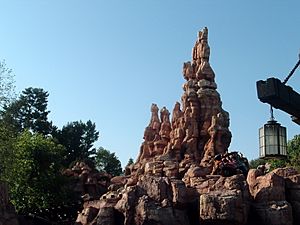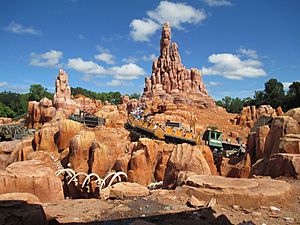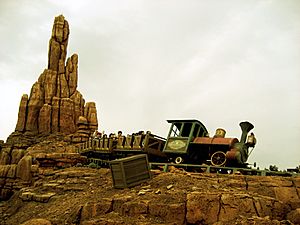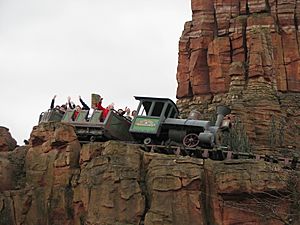Big Thunder Mountain Railroad facts for kids
Quick facts for kids Big Thunder Mountain Railroad |
|
|---|---|

Big Thunder Mountain Railroad entrance at Walt Disney World.
|
|
| Disneyland | |
| Park section | Frontierland |
| Coordinates | 33°48′47″N 117°55′13″W / 33.8130°N 117.9204°W |
| Status | Operating |
| Opening date | September 2, 1979 |
| Replaced | Mine Train Through Nature's Wonderland |
| Magic Kingdom | |
| Park section | Frontierland |
| Coordinates | 28°25′14″N 81°35′05″W / 28.4205°N 81.5848°W |
| Status | Operating |
| Opening date | September 23, 1980 |
| Tokyo Disneyland | |
| Park section | Westernland |
| Coordinates | 35°37′57″N 139°53′02″E / 35.6326°N 139.8839°E |
| Status | Operating |
| Opening date | July 4, 1987 |
| Disneyland Park (Paris) | |
| Park section | Frontierland |
| Coordinates | 48°52′15″N 2°46′32″E / 48.8707°N 2.7756°E |
| Status | Operating |
| Opening date | April 12, 1992 |
| General statistics | |
| Type | Steel – Mine Train |
| Designer | Walt Disney Imagineering |
| Model | Mine Train |
| Track layout | Custom |
| Lift/launch system | Chain lift hill |
| Height | 104 ft (32 m) |
| Speed | 35 mph (56 km/h) |
| Inversions | 0 |
| Duration | varies (about 3 minutes) |
| Height restriction | 40 in (102 cm) |
| Manufacturer | Arrow Development (1979 California build, Florida) Dynamic Structures (2014 California rebuild) Vekoma (Paris, Tokyo) |
| Sponsor | Dai-ichi Life (Tokyo) |
| Restraints | Single Lap Bar |
|
|
|
|
|
|
Big Thunder Mountain Railroad is a mine train roller coaster located in Frontierland at several Disneyland-style Disney Parks worldwide. The ride exists at Disneyland Park (California) and the Magic Kingdom at Walt Disney World as Big Thunder Mountain Railroad, and at Tokyo Disneyland and Disneyland Park (Paris) as Big Thunder Mountain. Big Thunder Mountain Railroad is also the name of the fictional rail line the roller coaster depicts.
Contents
Theme
Although the details of the backstory vary from park to park, all follow the same general story arc. Some time in the late 1800s, gold was discovered on Big Thunder Mountain in the American Southwest. Overnight, a small mining town became a thriving one (Rainbow Ridge in Disneyland; Tumbleweed in Florida; Thunder Mesa in Disneyland Paris). Mining was prosperous, and an extensive line of mine trains was set up to transport the ore. Unknown to the settlers, the mountain was a sacred spot to local Native Americans and was cursed.
Before long, the settlers' desecration of the mountain caused a great tragedy, which, depending on the park, is usually depicted to be an earthquake (Disneyland and Disneyland Paris), a tsunami (Tokyo Disneyland), a flash flood (Walt Disney World), which befell the mines and town, and the town was abandoned. Some time later, the locomotives were found to be racing around the mountain on their own, without engineers or a crew. The Big Thunder Mountain Railroad was founded in the old mining camp to allow wanderers to take rides on the possessed trains.
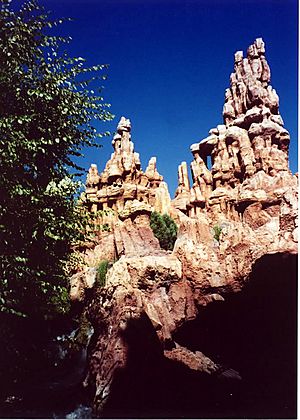
The detailed backstory, while present in park literature and training materials, is not communicated to park guests directly. The station buildings on all four versions of the ride are themed to appearance of a mining company office from the mid to late 19th century. In the Disneyland park, there is music and laughing in one of the saloons of Rainbow Ridge, and a typewriter is heard from a newspaper office. The mountains themselves are themed to the red rock formations of the American Southwest. The rock work designs in the Disneyland version are based on the hoodoos of Bryce Canyon National Park in Utah. In the Florida, Tokyo and Paris versions of the ride, the rockwork designs are based on the rising buttes that are located in Arizona and Utah's Monument Valley. Special care was taken by the Imagineers to make it appear that the rocks were there originally, and the track was built around the rocks, unlike a number of earlier mine rides, which were built the other way around (by sculpting the rocks around the tracks). There is also a dinosaur skeleton that the train passes by in all versions of the ride except the Paris version. A cracked eggshell is nearby, and there is a pleasant lake with water that is shot up while the train passes on the warmer days. Sound effects of a typical locomotive operation are piped into the surrounding scenery to add realism to guests viewing the ride from observation platforms, including the steam whistle sounding, even though there is no whistle displayed on the locomotives.
History
Big Thunder Mountain Railroad was designed by Imagineer Tony Baxter and ride design engineer Bill Watkins. The concept came from Baxter's work on fellow Imagineer Marc Davis's concept for the Western River Expedition, a western-themed pavilion at the Magic Kingdom, designed to look like an enormous plateau and contain many rides, including a runaway mine train roller coaster. However, because the pavilion as a whole was deemed too expensive in light of the construction and 1973 opening of Pirates of the Caribbean, Baxter proposed severing the mine train and building it as a separate attraction.
The Big Thunder Mountain Railroad project was put on hold again in 1974 as resources and personnel were being diverted to work on constructing Space Mountain in Tomorrowland, but this delay may have ultimately produced a smoother ride as the use of computers in attraction design was just beginning when the project was resumed. Big Thunder Mountain Railroad was one of the first Disney rides to utilize computer-aided design. The attraction first opened at Disneyland in 1979, and the Magic Kingdom's larger version in Florida opened in 1980. Tokyo Disneyland's version opened in 1987 and Disneyland Paris opened with its version in 1992. The Paris version's layout and structure were mostly based on the Florida version of the ride, but is situated on a large island in the center of the Rivers of the Far West, accessed from its riverside station by tunnels underneath the water. The attraction in Disneyland Paris is the only Big Thunder Mountain to have been an opening-day attraction at its park. Hong Kong Disneyland and Shanghai Disneyland does not have a Big Thunder Mountain Railroad attraction (or a western-themed Frontierland, for that matter). However, Grizzly Gulch has a theme similar to Frontierland. The main attraction, Big Grizzly Mountain Runaway Mine Cars, carries a similar theme to Big Thunder Mountain Railroad.
Timeline
- 1972-3: Big Thunder Mountain Railroad was conceived by Imagineer Tony Baxter for Walt Disney World, but it was put on hold due to the construction of Pirates of the Caribbean in Florida.
- 1974: The project is put on hold again due to the construction of Space Mountain.
- 1977: Construction begins on the ride at Disneyland.
- September 2, 1979: Big Thunder Mountain Railroad officially opens at Disneyland.
- November 15, 1980: Big Thunder Mountain Railroad officially opens at Walt Disney World's Magic Kingdom.
- July 4, 1987: Big Thunder Mountain officially opens at Tokyo Disneyland.
- April 12, 1992: Big Thunder Mountain officially opens at Disneyland Paris along with the park.
- March 17, 2014: Big Thunder Mountain Railroad reopens at Disneyland following a 14-month refurbishment that included an entire replacement of new track (similar to the Space Mountain refurbishment) by Dynamic Attractions, new trains, new scenery, and new effects.
- November 2, 2015: Big Thunder Mountain closes at Disneyland Paris for a year-long refurbishment. Its reopening is scheduled for December 17, 2016.
- August 8, 2016: Big Thunder Mountain Railroad closes at the Magic Kingdom for a 4-month refurbishment. Its reopening is scheduled for November 19, 2016.
- December 6, 2020: Since Walt Disney World reopened, after being temporarily closed during the ongoing COVID-19 pandemic, Magic Kingdom had announced that Big Thunder Mountain Railroad will be close temporarily at Magic Kingdom for the refurbishment. Its reopening is scheduled for 2021 in the time for Walt Disney World's 50th Anniversary celebration.
Tributes to predecessor
At Disneyland, Big Thunder Mountain Railroad was built on the land the Mine Train Through Nature's Wonderland used to occupy. Several tributes to the former attraction are present in the Disneyland version. A scaled-down Western town sits adjacent to the queuing lines and tracks near the station. A Western saloon, hotel, assayer's office and mercantile appear among the buildings. This is the village of Rainbow Ridge, which used to overlook the loading platform of the sedate Mine Train through Nature's Wonderland. Many of the animal animatronics throughout the attraction are animatronic animals from the previous attraction. Other allusions to the Mine Train through Nature's Wonderland include the Rainbow Caverns (glowing pools of water by the first lift hill) and precariously balanced rocks in the third lift hill tunnel. The name of the ride itself, "Big Thunder", was originally the name of a large waterfall the old mine train passed on its tour. "Little Thunder" was located nearby.
Name
At the Magic Kingdom and at Disneyland, the ride is known by its full name of "Big Thunder Mountain Railroad". The Tokyo and Paris versions would drop the word "Railroad" in favor of the name "Big Thunder Mountain", though the full name is still present on the trains. Tokyo Disneyland's Big Thunder, which is almost identical to the Magic Kingdom's, opened in 1987, five years after the park opened. At Magic Kingdom and Disneyland, the name of the ride is sometimes shortened to "Big Thunder Mountain", "Big Thunder", "Thunder Mountain Railroad" or "Thunder Mountain".
Kidney stones
In the October 2016 Journal of the American Osteopathic Association, a paper entitled "Validation of a Functional Pyelocalyceal Renal Model for the Evaluation of Renal Calculi Passage While Riding a Roller Coaster" was published. The paper's author, Dr. Wartinger, found that patients of his had passed kidney stones after riding Big Thunder Mountain Railroad at Walt Disney World on vacation, including one who passed three stones on three separate occasions. The doctor then tested this result, with the permission of Disney, with a 3D model of a kidney by riding the ride over 20 times. The study found nearly 70% of the time, the kidney stone was passed, with results varying depending on which row they were in. The study also found that the Space Mountain and Rock 'n' Roller Coaster Starring Aerosmith failed to cause this result.
Ride experience
Disneyland version
While the design of the Walt Disney World version of this roller coaster was done first, Disneyland's version was the first one to open. The track layout was mirrored, placing the attraction to the right of Rivers of America, if viewed from the central hub. (In Walt Disney World, the attraction is located to the left of Rivers of America.) To better fit with the adjacent Fantasyland areas of the theme park, the original Walt Disney World design had to be replaced with something more appropriate for Disneyland. The Florida, Tokyo and Paris versions of the ride use sharp-edged mountains and the vibrant colors of Monument Valley, Arizona, while Disneyland's version was developed with more rounded features and muted colors resembling the Bryce Canyon hoodoos in Utah.
Upon entering the attraction, the queue winds through a narrow rock wall and passing by the tracks. The surrounding walls were originally created from 100 tons of gold ore from Rosamond.
Leaving the outdoor station, trains enter a bat-infested tunnel, make a right hand turn, then a left hand turn before climbing the first lift hill, which takes trains through a cavern full of stalactites. Leaving the lift hill, the train drops away to the right, then levels out and makes a left hand turn. The track then crosses under the second lift hill drop before making a right hand turn. The sounds of coyotes can be heard howling at the train as it dives into a cave. At the end of the tunnel, the train hits a trim brake, exits the tunnel, and climbs the second lift hill. At the top of the lift, an animatronic goat bleats at passing guests as the train drops away to the right, crosses under the lift hill, and rises up into a downward spiraling clockwise helix. Leaving the helix, the train shoots through a small canyon, then drops down into a mining camp, where it hits another trim brake. The train then makes a left hand turn, enters another tunnel, and climbs the third lift hill. As the train climbs the lift, the tunnel is dynamited, and artificial smoke is blasted in guests' faces as the train crests the lift and exits the tunnel. The train then drops to the right, towards the river, then makes a right hand turn and passes through a short tunnel. After crossing over the drop, the trains make a left hand turn as they pass through the ribcage of a T-rex skeleton, hit a trim brake, then make a right hand turn into the final brakes. The train then travels by the buildings of Rainbow Ridge as it returns to the station.
California's version of the ride is the only version of the ride to feature an outdoor station. All of the other versions feature an indoor station.
On January 7, 2013, the ride was closed for an extensive refurbishment that included a new track, trains, scenery, and new effects on the third lift hill. The attraction reopened on March 17, 2014. The new track was fabricated by Dynamic Structures, the company that had previously rehauled the coaster track in Space Mountain.
Magic Kingdom version
The track layout of the Magic Kingdom's version is identical to the Disneyland version, with the exception of one section during the first act.
Riders board the trains in an enclosed loading station on a hillside. Leaving the station, trains make a left hand turn into a bat-infested tunnel, make a slight right turn, and climb the first lift hill. At the top of the lift hill, trains pass under a waterfall and drop to the left. This is followed by a right hand turn, after which the track crosses under the second lift hill and drop. After crossing under the second lift hill drop, the track goes through a 270 degree clockwise spiral and passes through a short tunnel. Trains emerge from the tunnel and pass through the flooded town of Tumbleweed, running parallel to the Walt Disney World Railroad. The train passes over a decaying trestle (where the track is slightly banked from side to side), before entering Davy Jones Mine, where it hits a trim brake. Trains then make a left hand turn and climb the second lift hill.
At the top of the second lift hill, trains drop to the left and cross under the lift hill, before rising into a 540 degree downhill counterclockwise helix, passing over a broken trestle. Leaving the helix, trains shoot up across a small hill, make a slight right turn, then drop through another tunnel and hit a trim brake. The trains then make a right hand turn into a tunnel and climb the third lift hill. As the train climbs the lift, an earthquake hits and makes the train cars sway from side to side (the effect achieved by slightly banking the track). Leaving the lift, trains emerge from the tunnel, crest a small rise, and drop to the left towards the Rivers of America. After traveling along a short section of straight track, the ride then makes a left hand turn through a short tunnel and crosses a short bridge. The train then makes a right hand turn, and passes through the ribcage of a T-Rex skeleton as it hits the final trim brake, makes a left hand turn past some geysers and hot springs, and rises into the final brakes. The train then makes a left turn back into the station.
The Florida version was allocated more space in the park, and so the Monument Valley-inspired ride structure assumes 2.5 acres, 25 percent larger than the Disneyland version. Due to the ride being surrounded by the Rivers of America on the east and Walt Disney World Railroad on the west, the maintenance facility for the trains is on the opposite side of the Railroad's track from the ride, with a swing bridge being used where the transfer track crosses the Railroad, just past the Frontierland station.
Tokyo Disneyland version
Big Thunder Mountain at Tokyo Disneyland is similar to the Florida ride, but there are some differences in the ride layout. Instead of Tumbleweed, the track makes a left turn and dives into a cave, mirroring the California version of the ride. More significantly, the final segment of the ride is different. Instead of crossing back over the drop from the third lift hill, the track makes a 180 degree turn to the right before dropping out of a tunnel, through the Boneyard/geyser scene, into a short tunnel. The track then makes a right hand turn into the final brakes. The trains pass in front of the station building, and then turn back into the loading area.
Disneyland Paris version
While primarily based on the Florida version, Paris's version is unique as it is situated on an island in the middle of the Rivers of the Far West, where Tom Sawyer's Island would normally sit. It is also the only version of the ride to be an opening day attraction and the largest installment at any Disney park. The Paris version underwent a year long refurbishment from November 2015 to December 2016. As part of the renovation, the brakes were overhauled, some of the scenery was repainted, and a few elements from the California version were added (rainbow pools of water on the first lift hill cave, new sound effects for the mine elevator on the second lift hill, new mapping effects for the blasting scene on the third lift hill). Interactive games were also installed in the queue.
Guests board the trains at a station on the mainland. Unlike the other versions, the trains on this version are painted to look weathered and aged. Immediately upon leaving the station, trains dive into a tunnel that transports them under the Rivers of the Far West to the island where the ride is located. The train makes a right hand turn, and makes a quick steep rise before starting up the first lift hill. As trains climb out of the darkness of the underwater tunnel, stalactites and stalagmites can be seen growing next to the track, along with several rainbow colored pools of water. The sounds of bats swooping up above can also be heard. During warmer months, a waterfall parts around the track at the top of the hill. Trains pop out of the tunnel, leave the lift hill, and drop around a left hand turn, pass through a small cave, then make a swooping right turn. If the trains are being dispatched timely, when the train goes through this curve, it will appear to make a near miss with a train in the 540 degree helix.
After this turn, the trains pass under the second lift hill and its drop, making a slight hop, before making a left hand turn onto a trestle. The train runs along the Rivers of the Far West, across the water from Phantom Manor, then makes a slight right hand turn, and suddenly falls through a washed out section of the trestle, hitting a magnetic trim brake. The trestle drop also contains an on-ride camera. After dropping down to the water level (with water jets on the sides of the track simulating a splashdown), the trains go around a left turn and hit the base of the second lift hill.
As trains start up the lift hill, two tied down donkeys can be seen to the right side of the track, braying at passing trains, with an empty watering pail in front of them. A goat can be seen pulling on a shirt hanging on a clothesline to the riders' left, as the trains pass a parked steamroller and mine elevator, and travel under a water tower.
At the top of the lift, it is possible for guests to catch a glimpse of The Twilight Zone Tower of Terror at Walt Disney Studios Paris on the horizon before the trains drop around a left turn and cross back under the lift hill. Coming out of the drop, the track goes over another rise, hitting a magnetic trim brake, and passes a sign warning of a broken trestle mounted to the water tower post. Cresting the hill, trains cross over the broken trestle and spiral down through a 540-degree counter-clockwise helix.
Exiting the helix, the trains pass through a short cave and go over a quick airtime hill as they shoot down a canyon. As the trains drop through the tunnel and pass over a trim brake, a loud gust of wind is heard. Trains then make a right hand turn on another trestle, enter a tunnel with signs warning of blasting over the portal, and climb the third lift hill.
As the train starts up the third hill, the tunnel is dynamited, and artificial smoke is blasted in guests' faces as the train crests the lift and exits the tunnel. The train crests a small hill, then drops to the left onto a straightaway alongside the river, speeding up as it enters the return tunnel. The train encounters a swarm of bats in the tunnel as it makes another sharp counter-clockwise turnaround and goes down a steep drop to cross under the water. The trains continue to accelerate through the dark until it pops out of the exit portal on the mainland. An additional chain lift is located here to assist the train in leaving the tunnel. The train then coasts past the station, through the loading dock, and then makes a left turn to reenter the station.
In other media
In film
The sounds of Disneyland's Big Thunder Mountain Railroad trains were recorded and used as sound effects for the mine cart chase sequence in Steven Spielberg and George Lucas' 1984 film, Indiana Jones and the Temple of Doom. Disneyland would later get its own Indiana Jones attraction in 1995, and the Walt Disney Company would go on to acquire the Indiana Jones franchise with its purchase of Lucasfilm in 2012.
Television series
In January 2013, ABC ordered a pilot based on the ride titled Big Thunder Mountain, but the idea was scrapped sometime after.
Print media
In October 2014, Marvel Comics announced a five-issue series based on the attraction, which eventually debuted in early 2015. Part of Marvel's "Disney Kingdoms" line, the series elaborated on the story behind the attraction and featured input from Walt Disney Imagineering, including numerous nods to elements of the ride.


